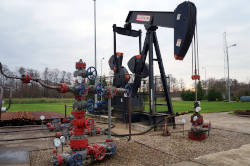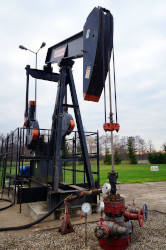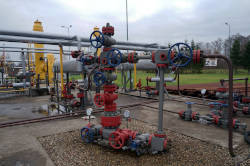Crude Oil Mines
Bitumen Mines - Tar Mines - Asphalt Mine




This page has a rather unusual title: Crude Oil Mine. Petroleum (petra oleum or rock oil) is a liquid substance and is therefore not extracted by normal mining. This resource is drilled and then pushes to the surface by itself due to its pressure, at least at first. The uncontrolled release of oil and gas from a well while drilling was known as an oil gusher, gusher, blowout or wild well. Due to their natural gas content, however, these blowouts were extremely explosive and were soon prevented by appropriate pressure valves around the well. After all, the escaping oil was environmental pollution, moreover, it was lost for commercial use, and finally, the pressure could be wonderfully used to extract the oil if it did not escape uncontrollably. Later, such incidents only happened as accidents and often led to a well burning.
When the oil reservoir’s own pressure is exhausted, the oil must be pumped to the surface. If that doesn’t help any more, water is pressed down to drive out the remaining oil. And for some time now there has been an even more aggressive extraction method, fracking, in which oil is even to be driven out of the rock. Nevertheless, the extraction of mineral resources underground must be called mining. Nevertheless, in this case one rather speaks of oil extraction.
Very often it is naively assumed that the extraction of petroleum must lead to huge underground caverns, after all the oil is pumped out. Of course, this is not quite true, the oil is located in pore space, i.e. in small cavities in the rock. If there is no more oil there, it is replaced by groundwater. In the mining process, the substitute, the water, is even pressed down and then replaces the oil.
In general, however, petroleum is a mixture of various hydrocarbons and can occur in different forms. For example, there is oil shale, an oil-bearing sedimentary rock also known as petroleum source rock. This can be mined and the oil it contains can be expelled by heating. If the oil content is high enough, the oil shale even burns, although not very well, and can be used for heating. This was done during the Third Reich to extract oil for petrol. However, the process is not economical.
Then there is oil sand, which is unconsolidated sand, or a very soft (incompetent) layer of sandstone that has been soaked with petroleum. The advantage with oil sand is that it is very easy to mine. You can simply shovel it. In exceptional cases, this was even done underground, for example in Wietze.
And finally there is the term asphalt, in geosciences this term refers to a dark brown to black, tough or solid mixture without any significant mineral substance, Other names include bitumen, natural asphalt, earth pitch or mountain tar. However, it has little to do with the term asphalt in road construction; asphalt is an artificial mixture of tar and sand, optimised for use as a road surface.
Another important aspect is the mining of petroleum as stone oil for medicinal or cosmetic reasons. It was mainly used externally, but even finds its use in medicines. In larger quantities, oil is toxic and carcinogenic in the long term. However, the irritation caused by the rather unhealthy substance is sometimes an incentive for the body to intensify self-healing. And so stone oil was used for eczema, rashes and dandruff. The quantities required are small and were dissolved from the rock by heat, either by burning wood or the oil shale.
The number of oil related mining museum is rather small. In Europe there are in general one such museum per country. In other words the oil industry is strongly underrepresented. We are not sure why, but we guess oil mining is not very interesting compared to traditional mining.
- Examples
 Almond Valley Heritage Centre, Great Britain
Almond Valley Heritage Centre, Great Britain Muzeum Przemysłu Naftowego i Gazowniczego im. Ignacego Łukasiewicza, Poland
Muzeum Przemysłu Naftowego i Gazowniczego im. Ignacego Łukasiewicza, Poland Skansen Przemysłu Naftowego „Magdalena” w Gorlicach
Skansen Przemysłu Naftowego „Magdalena” w Gorlicach Kohtla-Järve Põlevkivimuuseum, Estonia
Kohtla-Järve Põlevkivimuuseum, Estonia Canadian Energy Museum, Canada
Canadian Energy Museum, Canada Magyar Olaj- és Gázipari Múzeum, Hungary
Magyar Olaj- és Gázipari Múzeum, Hungary Oljeön, Sweden
Oljeön, Sweden Norsk Oljemuseum, Norway
Norsk Oljemuseum, Norway Schaubergwerk Pertisau, Austria
Schaubergwerk Pertisau, Austria Parco Museo del Petrolio e delle Energie, Italy
Parco Museo del Petrolio e delle Energie, Italy Erdöl-Erdgas Museum Prottes, Austria
Erdöl-Erdgas Museum Prottes, Austria Erdölmuseum Reinkenhagen
Erdölmuseum Reinkenhagen Tar Tunnel, Great Britain
Tar Tunnel, Great Britain Mines d’Asphalte Site de la Presta à Travers, Switzerland
Mines d’Asphalte Site de la Presta à Travers, Switzerland Erdöl-Erdgas-Museum Twist, Germany
Erdöl-Erdgas-Museum Twist, Germany Deutsches Erdölmuseum Wietze, Germany
Deutsches Erdölmuseum Wietze, Germany Musée du Pétrole, France
Musée du Pétrole, France
 Search DuckDuckGo for "Crude Oil Mine"
Search DuckDuckGo for "Crude Oil Mine" Crude Oil - Wikipedia
Crude Oil - Wikipedia Network of European Oil and Gas Museums (visited: 29-MAY-2022)
Network of European Oil and Gas Museums (visited: 29-MAY-2022)
 Index
Index Topics
Topics Hierarchical
Hierarchical Countries
Countries Maps
Maps